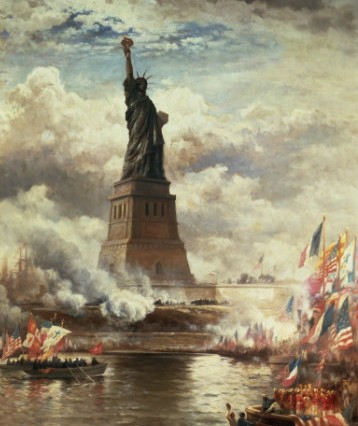Born in Bolton, Lancashire, England to a humble family of hand-loom weavers, Edward Moran (1829–1901) eventually became a successful painter, especially well known for his paintings of marine subjects. His younger brothers Peter and Thomas, his sons Edward Percy and Leon, and his nephew Jean Leon Gerome Ferris all, too, became prominent American artists.
Even as a child, Moran was interested in drawing, at times getting in trouble for sketching instead of helping his parents with the loom. At age 15, he and his family immigrated to the United States, where they settled in Maryland. Moran continued in the family business, finding employment at a textile factory. His supervisor at the factory, after discovering Moran drawing at work, encouraged him to pursue his interests and introduced him to Paul Weber, a German landscape artist then living in Philadelphia.
Moran moved to New York in 1872, becoming an associate of the National Academy of Design in 1874. There he began to experiment with luminism, a style of landscape painting in which light and hazy brushstrokes are used to lend emotion to the subject. In early 1876, Moran met French sculptor Frédéric Auguste Bartholdi, who told Moran of his plan to create a monumental statue in the New York Harbor titled Liberty Enlightening the World—more commonly known as the Statue of Liberty. Inspired by Bartholdi’s idea, Moran painted The Commerce of Nations Paying Homage to Liberty (1876), which was then displayed at fundraising events for the building of the statue.
In 1877, he moved to France, where he encountered the work of various impressionist and Barbizon school artists who painted en plein air (in the open air); two years later, he returned to New York, focused on the maritime scenes for which he would become famous. Much of his career would be spent working on a series of 13 canvases representing the maritime history of the United States from the landing of Leif Ericson to the Spanish-American War.
In the 1880s, while Moran was continuing to develop as a painter, Bartholdi was working to bring his vision for Liberty Enlightening the World to life. With the support of fundraisers in the United States and France and the help of other sculptors, the statue was completed in France in 1884 and arrived in New York Harbor in June 1885, broken down into 350 pieces and packed into 214 shipping crates.
On October 28, 1886 thousands of spectators—including Moran—gathered for the dedication of the statue. Moran’s Unveiling the Statue of Liberty (1886) depicts the moment when the assembled warships fired a 21-gun salute to welcome President Grover Cleveland onto Bedloe’s Island for the dedication ceremony. In the painting, ships flying French and American flags fill the harbor as smoke from the salute rolls across the island; above, Liberty stands clear, torch raised to the sky. In her other hand, she holds the tablet of the law, upon which is inscribed the date of the adoption of the Declaration of Independence: July 4, 1776.
What mood does Moran’s painting convey to you, and how does it do so? For the millions of immigrants who have reached the United States through New York Harbor, the Statue of Liberty has been the first glimpse of their new land. Does the appearance of Lady Liberty, so well captured in Moran’s painting, strike you as especially welcoming? In the painting, the smoke from the guns fills the harbor but seamlessly merges with the background sky. Why might this be a fitting background against which to view the statue? Is there anything in the picture to suggest that the Statue of Liberty is a universal, and not just an American, symbol? What is the connection between the statue’s torch of liberty and its tablet of law? What does that connection imply about the relation between freedom and the rule of law?



Post a Comment